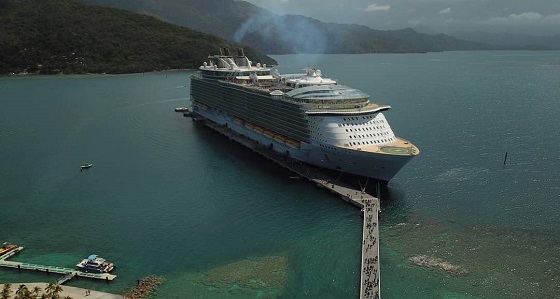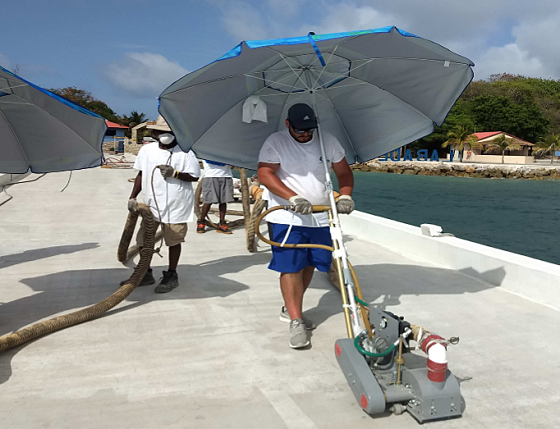Located on Haiti’s northern coast, Labadee is a private beach destination for a major cruise line operator in the Caribbean region. Perhaps the most visible—and certainly the most traveled—portion of the cruise port is an extended concrete pier, which the cruise operator utilizes to load and unload tourists between its vessels and the pristine beach.
After many successful years of operation, though, the pier’s original three-coat catalyzed epoxy system with granular anti-slip additives had begun to fail. As a result, regional contractor Quality Sandblasting, Inc. (Fort Lauderdale, Florida, USA) was asked to install a new deck coating system to mitigate any potential corrosion and protect against the impact of heavy foot traffic during the peak summer travel season. Upon arriving at the 40,000-ft² (3,716 m²) jobsite in 2018, though, the contractor quickly realized that this job posed some unique challenges.
Coastal Considerations
For starters, the pier had to remain operational throughout the three-month summertime project. Every third day, a ship would dock and unload thousands of passengers to spend the day at the resort before leaving that night. During that time, no work could be performed, and the pier had to be completely free of all debris and equipment. From the contractor’s perspective, this required complete demobilization.

Also complicating matters was Haiti’s tropical climate. Jobsite temperatures routinely reached 100 °F (38 °C) during the summer, with surface temperatures rising to as high as 120 °F (49 °C). This slowed progress on two fronts: first, due to the technical properties of the coatings and tools involved, and second, because the seven-person crew needed extra breaks to stay hydrated.
But the biggest challenge involved surface preparation. Ideally, the 30 to 60 mils (762 to 1,524 microns) of the prior epoxy system—with an extra ~20 mils (500 µm) in spots such as yellow-painted warning lines, demarcations, and helicopter pad areas—would have been blasted off. On this jobsite, though, blasting would have resulted in a new set of problems.
“We had to have a surface acceptable to the coating manufacturer and with a good enough profile so that the coating would adhere,” explains Apostolis “Paul” Velisarios, president of Quality Sandblasting. “Then we had to be able to supply enough media in Haiti. Finally, we had to be very aware of any mess or contamination of the surrounding imported white sand beaches, coral, and, of course, the water. With abrasive blasting, the labor for cleanup and costs of disposal would have been double the project.”
Another Tool Bites the Dust
Given those difficulties, Velisarios initially expected to use larger grinders. But in seeking out information, he contacted surface preparation tools specialist Desco Manufacturing Inc. (Rancho Santa Margarita, California, USA) and quickly formed a relationship with Chris Patenaude, then the director of maritime and industrial sales and a NACE International-certified Coating Inspector Program (CIP) Level 3 Inspector.

“I was going to purchase a super expensive grinding machine,” Velisarios says. “Chris told me ‘No, I have these shrouded dust-free tools that will do the job.’ And he was right.” Patenaude’s expertise was especially useful on the cruise pier project, since he previously worked at the cruise line as global fleet superintendent for coatings and linings prior to joining Desco. Thus, he had firsthand knowledge of many of the common pitfalls of surface preparation in similar environments, as well as what the client’s needs would be.
On this job, the contractor utilized two Descobrader walk-behind scarifiers with cutter hubs to remove the surface and meet the International Concrete Repair Institute’s (ICRI) Concrete Surface Profile (CSP) 4 standard. To prepare curbing and side walls, the crew wielded 7-in (17.8 cm) hand-operated grinders with diamond segment wheels and DescoRip discs.
“Desco sent their expert [Patenaude] to the site to train and work with our people to ensure a successful project,” says Velisarios. “Using the tools, we were able to produce approximately 4,000 ft² [372 m²] per day of complete surface preparation, including debris removal. For me, surface preparation is always the most important thing.” In addition to on-site training and technical assistance, Patenaude personally verified that correct surface profile requirements were achieved.
Besides keeping surrounding areas clean, the tools also made life simpler for the crew. While typical personal protective equipment (PPE) was worn at the jobsite (e.g., protective gloves, safety glasses, and earplugs), respiratory protection was not required due to the shrouded tools and a 100% solids coating system. “We did still have respiratory protection available in the form of half-face respirators for any employee, just in case any need arose,” Velisarios says.
During the frequent hydration stoppages due to heat, crew members routinely checked the hubs and cutters for any signs of breakage or wear. When such issues were identified, replacement hubs were installed while the worn teeth in the out-of-service unit were replaced.

Preparation Makes Perfect
Once the surface was properly prepared, the final phase for each segment of the project was the application of a new coating system. Spray application was considered untenable for many of the same environmental considerations that prompted the use of shrouded preparation tools, so the Pecora (Harleysville, Pennsylvania, USA) decking system was applied by squeegee.
The system for most of the pier included the Pecora P-808 epoxy primer, installed at ~2 mils (51 microns) dry film thickness (DFT), the Pecora-Deck 802 basecoat at ~30 mils (762 microns), a Pecora-Deck 804 intermediate coat at ~14 mils (356 µm), and the Pecora-Deck 806 topcoat at ~12 mils (305 microns).
For the sides of the pier and bollards, a two-layer system consisting of the Sherwin-Williams Company (Cleveland, Ohio, USA) Macropoxy 646 fast-curing epoxy and Sher-Loxane 800 polysiloxane topcoat were installed, each at ~5 mils (127 microns) DFT. Two technical service representatives from Sherwin-Williams were at the jobsite to assist with application, and a PosiTector 6000 gauge from DeFelsko (Ogdensburg, New York, USA) was used to verify thicknesses.
Weather watching was a priority throughout the project, considering the propensity of pop-up thunderstorms in the tropics and Haiti’s extreme heat. At times, this forced the crew to delay application until temperatures and moisture levels were in a suitable range for coating. But after about three months, the seven-person crew completed its job to rave reviews.
“The system is doing very well,” Velisarios says. “It looks beautiful, and everybody is so happy. Now I’m getting ready to do our next project, which is another pier on a private island.” For this contractor, practice—and preparation—makes perfect!
Source: Desco Manufacturing, www.descomfg.com. Contact Chris Patenaude—email: cpatenaude@descomfg.com.
Reprinted with permission from the Summer 2019 issue of Maritime News.